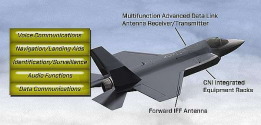This is often brought up as an AESA advantage, but in fact PESA radars are just as frequency agile as AESA. What an AESA can do, unlike most (but not all) PESA, is transmit at different frequencies simultaneously. But that's not frequency agility.===
The counterargument is that AESA is frequency agile in a way that PESA is not, since signals are generated by T/R modules under computer control, instead of being generated by a single magnetron and being phase-shifted.
Why must IFF be a feature of the radar? AFAIK, the F-35 has IFF functionality integrated in its wings.In other words, AESA doesn't need IFF dipoles because it can be done via software instead of having dedicated dipoles on the face of the array. The counter example would be the F-16 with IFF dipoles built onto the sides of the radar, but the implementation, first, resembles legacy features (i.e, the F-16 had IFF systems that didn't rely on the dipole before the AESA was installed, and these weren't removed), and second, the implementation (with IFF dipoles to the side, not within the AESA) is different.
I think it's most likely that the J-10B went through a PESA phase, before transitioning off to AESA.

Last edited:

